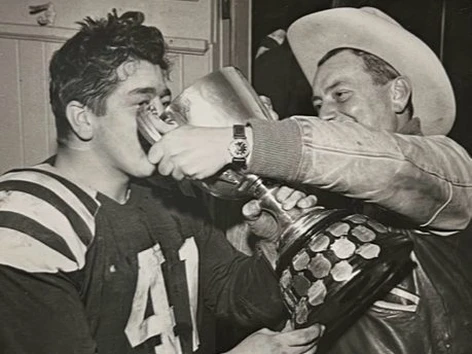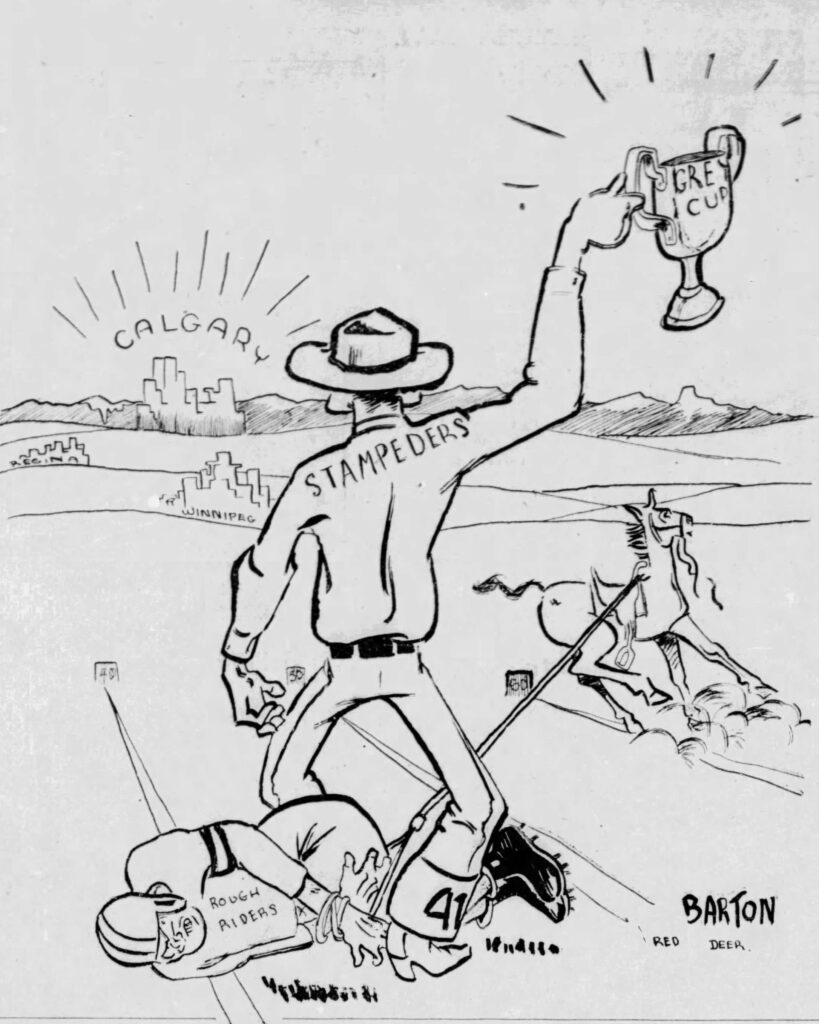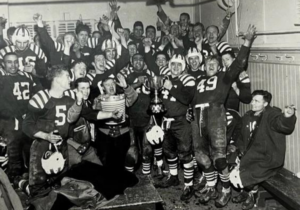By Todd Saelhof
A first Grey Cup victory for the Calgary Stampeders.
A first true festival for Canadian football fans.
And a first real wave of pride felt by Calgarians for their gridiron gang.
All of that came to life from the 36th Grey Cup held 75 years ago in Toronto.
Wow … what a time!
It was November 1948, and Calgary’s football club was just completing its fourth season — an historically perfect-ish one of 14-0-1, capped by the 12-7 triumph over the Ottawa Rough Riders in the championship game — under the ‘Stampeders’ moniker following five years away from the game because of the Second World War.
“They went through a bunch of names,” said Daryl Slade, the Calgary Stampeders’ official historian, recalling Calgary’s senior football team dating back through to 1911 Alberta Rugby Football Union campaign. “They were the Tigers. There were the Canucks, as well. There was the 50th Battalion. Then they became the Altomah-Tigers and then became the Bronks (and Bronks-Colts) for six years through 1940. And then for the war, they shut down.
“The Stampeders name had a lot to do with the people involved in putting the team together in 1945 who were directors of the Calgary Stampede. And there was a hockey team called the Stampeders, as well. So it was accepted right away.”
But it wasn’t until 1948 when Calgarians truly started to accept the team itself, which was then freshly adorn in the iconic red-and-white colours widely associated with the franchise today.
Winning, with a 12-0 regular season in the Western Interprovincial Football Union, had a lot to do with that upturn in love.
“They just had the whole backing of the community,” said Slade, who authored the book ‘1948 Grey Cup … The Stampeder Special’ chronicling that championship edition. “When this team was put together and started to win, people just jumped on the bandwagon, and it became more than football. It became that they were representing Calgary, and it was a big deal. The whole city got behind the team like never before.
“They’d always supported the team and done well. They had gotten to the Western final many times, but they couldn’t get over the hump. When they did turn around and make it a better team, they promoted it more. It turned into a more professional organization. They really got Calgarians worked up.”
That continued into what would become the only undefeated season in Canadian professional football.
In fact, the only blemish on the Stampeders 1948 record was a 4-4 draw with the Regina Roughriders in Game 1 of the two-game, total-point WIFU final.
But a Game 2 victory — 17-6 — by the Stamps over the Roughriders sent the Stamps off to the Grey Cup.
And with just two weeks before the title tilt in Toronto, a group of football-frenzied Calgarians got to work to join in on the fun, beginning with travel by train — alongside the team — to the championship game.
“They put a lot of effort into it,” Slade said. “And they spent a lot of money.”
While about 75 fans flew via airplane to the Grey Cup, hundreds more rode the rails.
The train was loaded with horses and chuckwagons and everything western.
Jim Cross, president of Calgary Brewing and Malting, even donated 500 cases of beer for the festive fans of the train. But the rowdy crowd ran out of suds by Broadview, Sask.
“So Gordie Clark, who was a native Calgarian and a real football fan, he scoured the town of Broadview and found a guy with a truck,” said Bob Rowe, son of then-Stamps captain Paul Rowe. “And they went to the liquor store, and they cleaned it out. So they had enough booze to get to Toronto.”
Once there, the Calgarians took T.O. by storm, setting off days of pre-game partying never before seen at the Grey Cup.
“It set the whole celebration of Grey Cup for the future,” Rowe said. “It became a festival after that.”
“Keep in mind, the league was still in its infancy,” agreed Greg Kwong, another son of a Stampeders winner that year in soon-to-be-CFL legend Normie Kwong. “It had just merged. Originally, it was that they were playing just in the East and West, and the league was finally a true national league.”
Indeed, in its fourth year as a championship contest featuring representatives from both ends of the country, it became a grand ol’ time in Toronto.
And the hundreds of Calgarians on hand were at the forefront.
“They had pancake breakfasts,” Slade said. “They had dancing in the streets. They had all the horses on the street in front of the Royal York Hotel and city hall. They turned it into a whole party, which had never been done before.
“Previously, it was just the game itself, and that was it — people came to the game, watched the game and went home.
“So this changed the image of the Grey Cup into this festival. Everybody took part in it, and it was a big deal and has been a big deal ever since.”

1948 Calgary Stampeders featured fair share of stars
The 1948 Stampeders made Mewata Stadium west of downtown — capacity 7,500 — their home.
And by all accounts, the team featured its fair share of stars, including talent brought in from California, Vancouver and Winnipeg.
Captain Rowe was a linebacker, fullback and kickoff specialist — a true athlete and the only Canuck ever to be named to eight halls of fame, including both the Canadian Football Hall of Fame and Canada’s Sports Hall of Fame.
Keith Spaith was the quarterback — a two-time winner of the Jeff Nicklin Memorial Trophy as best player in the West — the punter and a defensive star, even intercepting a pass in the Grey Cup win.
Woody Strode, who went on to become an acclaimed Hollywood actor, was the team’s top receiver.
Canadian Football Hall of Famer Fritz Hanson brought a veteran presence to the Stamps after being a five-time all-Western running back and three-time champ for the Blue Bombers.
At the other end of the age spectrum was teenager Kwong, who went on to become a CFL giant — earning a record for most yards rushing by a Canadian in a season with 1,437 in 1956 and becoming a shoo-in for the Canadian Football Hall of Fame and Canada’s Sports Hall of Fame.
And Chuck Anderson was a fierce lineman on both sides of the ball.
“My dad said Chuck Anderson was probably best player he’s ever played with — unofficially the MVP of Grey Cup game,” said Bob Rowe. “Ottawa couldn’t run against Calgary because of guys like Chuck.”
Nobody, it seemed, could run with the Calgary crew either.
Head coach Les Lear made sure of that.
Lear came to the Stamps as sideline boss from 1948-52 after starring as a player for the Winnipeg Blue Bombers and catching on in the NFL for four seasons.
The all-business coach put the team through its paces in training.
“My dad did talk about the training back then,” said Greg Kwong. “Back then, they did calisthenics and isometrics, which is resistance training. Right now, if you talk to any trainer about isometrics, they laugh. Basically, you used your own body — clasping your hands together and sticking your elbows out and pushing — to develop chest muscles.”
But it was team fitness that was the real calling card of that Stampeders edition.
“The week of that Grey Cup was torture for the Stampeders because Lear would have them on the field for two-and-a-half hours in the morning and two-and-a-half hours in the afternoon,” Rowe said. “And it was snowing like crazy, and the food wasn’t very good. So they didn’t like that very much.
“But Les pulled a bunch of young guys together and worked their butts off and got them in great physical condition, and they went undefeated that year.”
And eventually became champions.
‘Calgary were underdogs — serious underdogs — for that Grey Cup game’
The 36th Grey Cup was played Nov. 27 at Toronto’s Varsity Stadium — as was usually the case, since that’s where it was hosted for 30 of the first 45 Grey Cup games.
And the Rough Riders went in as heavy favourites to claim the championship fought between the WIFU winners out west and the champs of the Interprovincial Rugby Football Union — or ‘The Big Four’ — out east.
“Calgary were underdogs — serious underdogs — for that Grey Cup game,” Rowe said. “If you were a betting guy, you would’ve cleaned up — and a few Calgary guys bet heavily on the Stampeders, and y won.
“So no one really expected Calgary to win, except the players themselves.”
And so they made it happen in 12-7 fashion.
That was mostly due to eight turnovers, quite the fit crew and a famous trick-play engineered by the younger Stampeders.
“The ‘sleeper-play’ touchdown by Normie Hill in the second quarter was the play that caught Ottawa by surprise,” Slade said. “Les Lear had scouted the Eastern final between Hamilton and Ottawa, and he saw that Ottawa was using that kind of a sleeper play and complained about it to the Canadian Rugby Union. And he ended up using the same play.”
It came with help from a Canadian sports icon.
Not a football player on the field, but two-time world and 1948 Olympic figure skating champion Barbara Ann Scott.
Known as ‘Canada’s Sweetheart’, Scott walked into the stadium opposite of where Hill had laid down on the field by the sidelines after not returning to the huddle from the previous play.
The figure skater caught the eyes of mostly all in the stadium, including those of the Rough Riders, and at the snap of the ball, Hill got off the deck, took off down field and caught a pass from QB Keith Spaith while falling back into the endzone on his back-side.
“That’s recognized as one of the most unique plays in the Grey Cup,” Slade said. “So the Stampeders were ahead 6-1 at halftime.”
The Rough Riders scored themselves in the third quarter to take the lead 7-6.
But in the fourth and final stanza, the Stamps defence took advantage of a fumble by the Rough Riders QB and ran it back to the 10-yard line. Halfback Pete Thodos then ran the ball in from 10 yards out to put the winning points on the board.
“I think they were confident enough they were going to win,” Slade said. “Really, it was their defence that really did it.
“There were still 12 minutes left after that Thodos touchdown, but Calgary actually forced four turnovers after that — two fumbles and two interceptions.
“The Stampeders were in such good shape,” added Slade. “They were the most fit team in the country. Les Lear said, ‘We’ll win games in the fourth quarter.’ Their conditioning played a big part in being crowned Grey Cup champs.”

Horse in hotel lobby? Not so fast!
And so the celebration was on.
Stamps fans and players took the party from Varsity Stadium back to the Royal York Hotel after the game.
It was a marvellous and magical night — perhaps even fictional, where the story of the horse being in the hotel lobby is concerned.
“No horse in the hotel,” stated Rowe matter-of-factly. “Not in ’48. It’s all legend, and it’s been blown up over the years.
“In 1949, there was a horse that got into the Royal York Hotel. So people have just missed it by a year.
“The legend continues, though. There’s a lot of people who think it happened in ’48, but it didn’t.”
Certainly in subsequent years, horses representing the Stampeders — with a nod to 1948 — have made appearances in hotels during Grey Cups.
Just this Thursday, 18-year-old black mare Tuffy Nuff was ridden by Diane Wensel, the chair of the Calgary Grey Cup Committee, into Hamilton’s TownePlace Suites by Marriott during the 2023 festivities.
But back in ’48?
“I heard there actually was a horse in the lobby of the Royal York Hotel that year,” said Greg Kwong, 62. “No, I didn’t hear my dad confirm it. But I remember him talking about how it was a big deal that the Calgarians would do this. And you see the pictures about how they all had white cowboy hats on, so they had this mystique about them — this Western team.”
Slade says there were horses outside the hotel — in and around the breakfast area — but none that even approached the door to the Royal York.
He adds there were no photos captured of such a spectacle that year despite plenty of photographers on hand to document the events of the festival.
“I don’t believe the horse ever went in the hotel,” Slade said. “Everybody believes it did, but I’ve done a massive research on it and I’ve got stacks of newspapers from that time and there is no reference to a horse going into that hotel that year.
“Jim Coleman, a Globe and Mail writer at the time, made some off-handed comment in his column two days later about how Calgary took over Toronto by storm, and he wrote, ‘They did everything but put a horse in the elevator at the Royal York.’
“The horse couldn’t have even gone in the hotel,” continued Slade. “It was a marble floor. It was a turnstile door to go in. The only way was the back door through the freight elevator, and the horse wouldn’t have fit into the freight elevator.
“It’s just something that started many years later. I’m not going to spoil a historical legend. Most likely, it didn’t happen.”
But the magnitude of the bash?
That can’t be denied.
That can’t be denied.
“It was just a huge party — an unbelievable party,” added Bob Rowe. “It was just mayhem — they had a great time. The Royal York was just incredible — like it was shoulder to armpit and everybody drinking their faces off and having a grand ol’ time.
“And the trip back from Toronto to Calgary was one big party.”

Cross-country party train to Calgary
Yes, it was a riot on the rails, with the celebration being held on the train and at various towns along the way.
At every stop on the three-day ride back to Calgary, people came out by the hundreds to meet the players and see the Grey Cup.
Aboard the train, the party never stopped.
Fan-guy Clark somehow managed to bring home one set of the goalposts from Varsity Stadium, and former Stamps star George Alexander had the other, as part of the tomfoolery to be had in the wake of victory.
“My dad never drank in his life, and there was a lot of drinking involved,” said Greg Kwong, talking of the train ride. “Dad stayed for some of the partying but didn’t really get involved. Plus he was a rookie and had his mother (Lily) with him.”
Kwong, however, was known as quite the prankster, so he enjoyed his own brand of fun to mark the occasion.
“Normie was a real scamp on that team,” Rowe said. “He’d sneak in with a water pistol and let everybody have it. A good time was had by all.”
Eventually, they all returned to Calgary — timed perfectly for an afternoon parade downtown — with the Grey Cup in hand and plenty of fans to salute the Stamps’ achievement.
“It was a really big deal,” added Slade. “Because Calgary had never been in the Grey Cup before. The only time they had ever won the Western final before was as the Calgary Tigers in 1911, and that was before there was an East-West playoff. So it quite a big deal to for Calgary to be in the Grey Cup. They made it into a really big thing.
“The fact that they won it was really a bonus.”

Important business back home in Calgary
Captain Rowe had urgent business to attend to upon his return.
His wife, Vivian, had given birth to their baby boy, Bob, in Calgary’s Holy Cross Hospital on the morning of the actual game.
“My dad got the nickname ‘Pappy Rowe’ after that, and I got the name ‘Robert Arthur Grey Rowe,’” said Bob Rowe, who’s set to turn 75 on Nov. 27 and has authored the book ‘Pappy’ about his dad’s life and athletic endeavours. “After they won the Grey Cup, they sent a telegram to the Holy Cross saying, ‘Vivian, you have to name your son ‘Grey Cup.’’ And she sent a telegram back saying, ‘Well, no son of mine will have ‘Cup’ in his name, but ‘Grey’ doesn’t sound too bad.’
“So we kid around that Mom and I listened to the game on the radio. And then when Dad came back on the train, he limped into the hospital because he got injured in the game and said, ‘Move over, Vivian. I need that bed more than you do.’
“It was a good season for my dad. He won the Dave Dryburgh Memorial Award for being the leading scorer in the West. Just a natural. Dad played 60 minutes. For years, Dad hardly came off the field.”
Meanwhile, the young Kwong found victory off the field in the form of family approval.
“My grandparents discouraged my dad and my uncles and aunts from playing sports,” said Kwong’s son Greg. “Like a typical immigrant family, it was about studying hard and becoming a doctor. My grandparents didn’t really want them to play sports, so my dad had to hide his football equipment and his cleats and his helmet in the garage or underneath a bench — hide it from my grandmother specifically. He’d come home and was sometimes bruised, and she’d wonder what was going on with him. Fortunately, he was a good student — he kept his marks up.
“When his mother finally found out that he was playing in his Grade 11 or Grade 12 year, he was coming with high expectations — the newspapers got hold of who he was — and he was drafted by the Stamps.
“My grandmother was able to ride the victory train back from Toronto, which was quite a treat. The few times my dad would tell the story, he would get pretty emotional about it, because it was confirmation that he’d done the right thing and made his mother proud.”
The Calgary-born Kwong, whose life being a high-profile athlete, franchise owner, businessman and politician ended at age 86 in 2016, is the subject of a new Heritage Minute short film set to be released in February 2024.
‘Calgary really got jobbed in 1949 by the Eastern referees’
The 1949 season saw the Stampeders continue with their winning ways — for the most part.
In fact, they went 13-1 in the regular schedule to finish a sensational 25-1 over two seasons for another mark that has never been equalled in Canadian football.
The only loss came to the newly rebranded Saskatchewan Roughriders in a 9-6 Oct. 22 contest.
Three weeks later in the playoffs, they’d lose again to the Roughriders — this time 9-4 in Game 2 of the WIFU Finals.
But because of their 18-12 win in Game 1 of the two-game, total-point set, the Stamps were again crowned West kings and headed back to Toronto to defend their title in the 37th Grey Cup at Varsity Stadium.
“If you analyze that game, Calgary really got jobbed in 1949 by the Eastern referees,” said Slade of the 28-15 win by the Montreal Alouettes. “It was a mess. There were a lot of mistakes made in favour of Montreal in that game. It was very poorly refereed and very biased towards the East.”
Indeed, it was one-and-done for the Stamps for a very long time.
They didn’t capture the Grey Cup again until 1971, helping to make that ’48 edition even more special — and one to remember.
“There was a lot of racism back in those days,” said Greg Kwong. “But the team took my dad — an 18-year-old rookie — under their wing, and he felt part of the team right away.
“He still had a lot of friends from that team as they all retired.”
A 50-year reunion was organized for the 30-man squad in 1998, and all but one of the surviving 13 members came for the get-together in Calgary.
As time passed, so did those Stamps from the ’48 champs, with halfback Cedric Gyles the last to die — at age 96 — in early fall of this year.
But they left quite the legacy for all.
“It was just a great year for those guys,” added Bob Rowe. “Really a fantastic undefeated season. Everything went their way. They dominated the West and won the Grey Cup.
“First one for Calgary.”
(This article was originally published in the Calgary Sun on Nov. 17, 2023 and has been used here with the author’s permission: https://calgarysun.com/sports/football/cfl/calgary-stampeders/1948-grey-cup-champion-stampeders-ignite-football-festival-franchise-of-success.)

